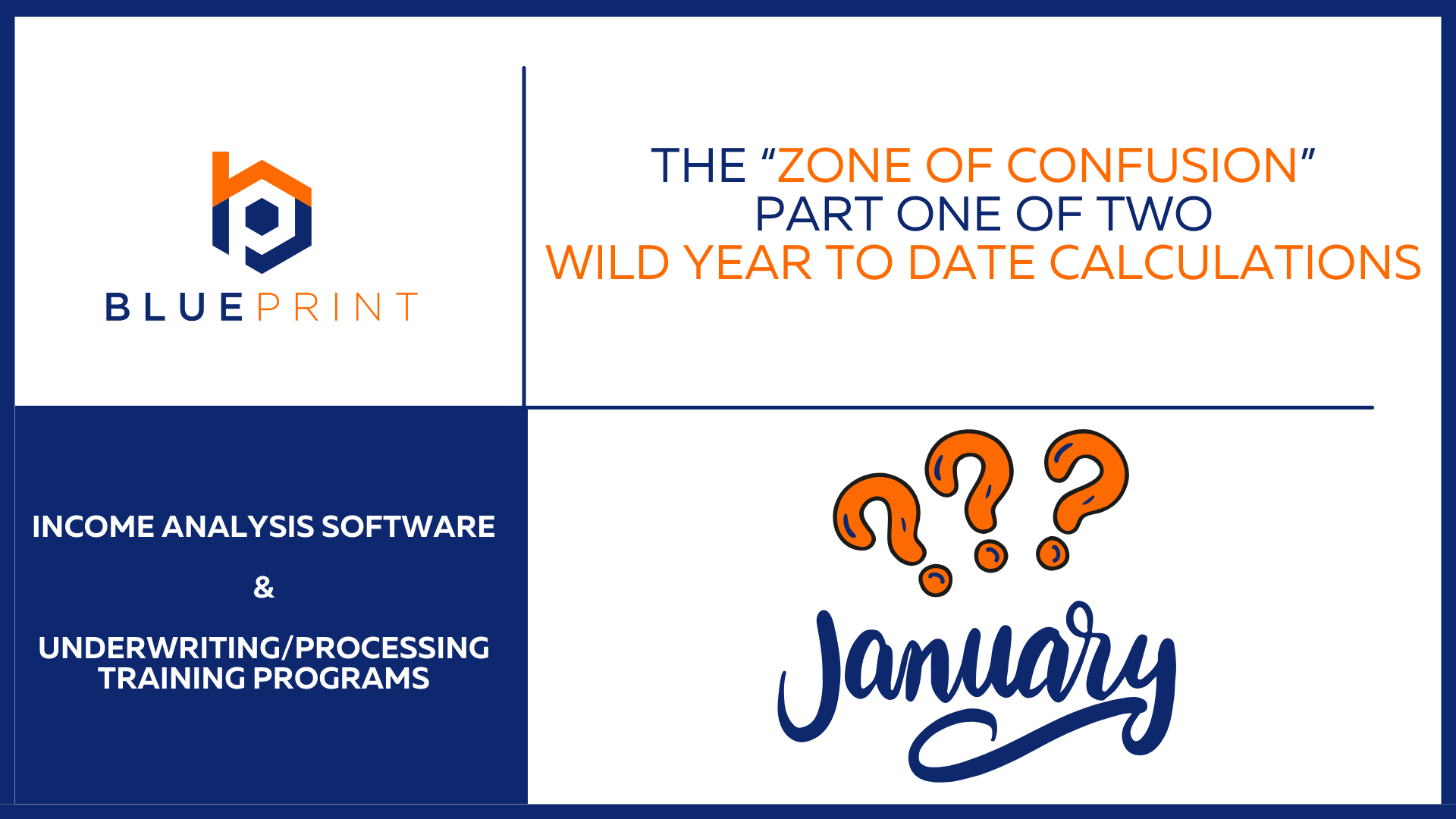Happy New Year 2024 from the Blueprint Team, and welcome to our Zone Of Confusion Blog, which has become a tradition for us to post as we go into our 11th year in business! Why do we post this blog as a tradition? Just like in life, we have fun traditions for the holidays (i.e. a ski trip at Christmas or friends over on New Year’s Day to watch the big college game). Some traditions are not quite as fun, but necessary. Examples include taking down the Christmas decorations, getting your taxes ready, and NOT falling into the “zone of confusion” for income analysis during the first quarter of the year!
The zone of confusion consists of two areas. The first is wild YTD calculations that happen on employed borrowers’ pay stubs early in the year. The second issue is what documentation is required as we roll into 2024! This blog we will cover the wild YTD calculations, and we will post a second blog on the documentations issue (Zone Of Confusion Part 2 – Documentation).
Wild YTD Calculations for Employed Borrowers
Like almost all systems, there are imperfections in income calculations for borrowers. These imperfections are very “wild” in January, but smooth out each month as the year progresses, so most people don’t notice them from February to December. What I mean is the Year To Date (YTD) numbers on January paystubs, all hourly borrowers, and some salary borrowers! Let me show you an example:
Paystub Example January 2024
As an underwriter, you are supposed to make sure that the borrower’s hours divided by YTD line up with what you see on the paystub. For example, a borrower’s pay stub shows they make $25 per hour full time (40 hours per week). You would expect to see $2,000 base pay every two weeks, and an average of $4333.33 per month for every month that goes by in the year. But here is what you see (in January especially)!!
Pay Date: Jan 12th 2024
Pay Period Covered: Dec 25th 2023 – Jan 6th 2024 (bi weekly period)
$2,000 base salary YTD with a $25 per hour rate, as of 01/12/24.
To confirm the borrower IS in fact full time, you do the following math:
- 6th day in Jan divided by total number of days in Jan 31 = 0.39 months YTD elapsed
- $2,000 / 0.19 months = YTD of $10,526.31 average
That is what causes the confusion!!! The question to our support box comes in, “Does my borrowers base pay = $4,333 per month or $10,526 per month? Why is the IncomeXpert tool so wrong here on the YTD?”
The answer is IncomeXpert is giving the correct answer. The $4,333.33 per month is the right answer. The imperfection every year is some income is earned in December and is not paid till January. Only six working days in January have passed, but the borrower earned $2,000, which is not correct. They earned $1,000 in December and $1,000 in January, but it was all PAID in January, making the YTD very elevated.
Effect of Time
As the weeks go by, the YTD does get more in line with the calculated rate. If we looked at that same borrower two pay periods later,we would see the following:
Pay Date: Feb 9th 2024
Pay Period Covered: Jan 22nd 2024 – Feb 3rd 2024 (bi weekly period)
$6,000 base salary YTD with a $25 per hour rate, as of Feb 3rd
To confirm the borrower IS in fact full time, you do the following math:
- 3rd day in Feb divided by total number of days in Feb 29 = 0.10 YTD elapsed now is 1.10
- $6,000 / 1.10 months = YTD of Feb 3rd = $5,454.55
Which is correct?
Now we go back to the question: Which is correct, the borrower earns $4,333.33 per month or $5,454.55 per month? The correct answer is $4,333.33 per month! The guidelines DO NOT allow you to go over a calculated rate (max 40 hours per week) for almost all borrowers. (example of who you could do more might be Firefighters or Police who work Kelley Shifts, which means they work more than 40 hours per week without getting overtime.
Wrapping Up
With all the technology today to more accurately calculate income and avoid mistakes like this, the agencies are pushing back. For example, one of the agencies uses our tool (IncomeXpert) on every loan sold to them to check income. The level of precision I laid out above is built into IncomeXpert, and this level of precision is what the agencies are expecting to see when you sell them loans.
Look for our second blog here, Zone Of Confusion Part 2 – Documentation.

